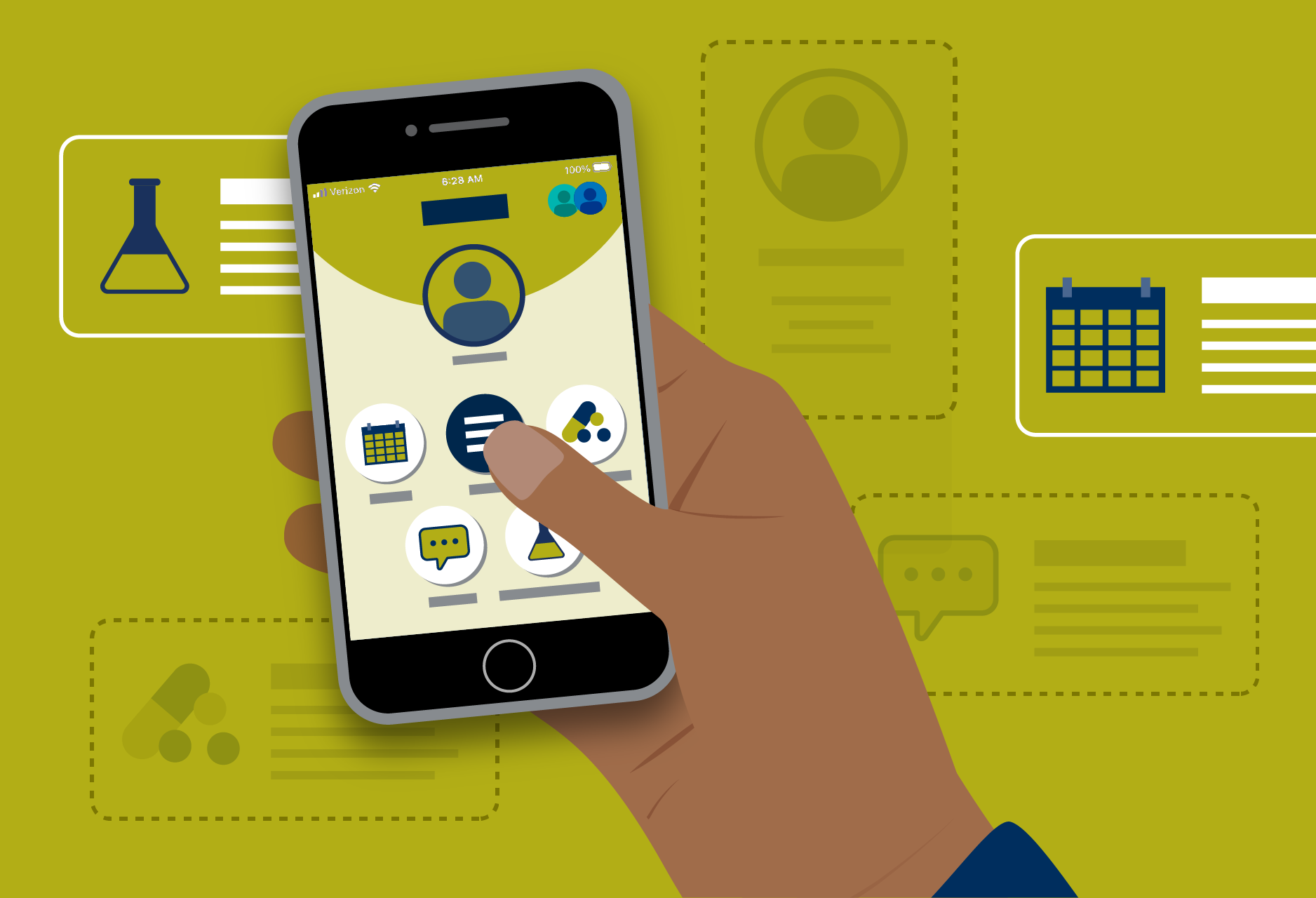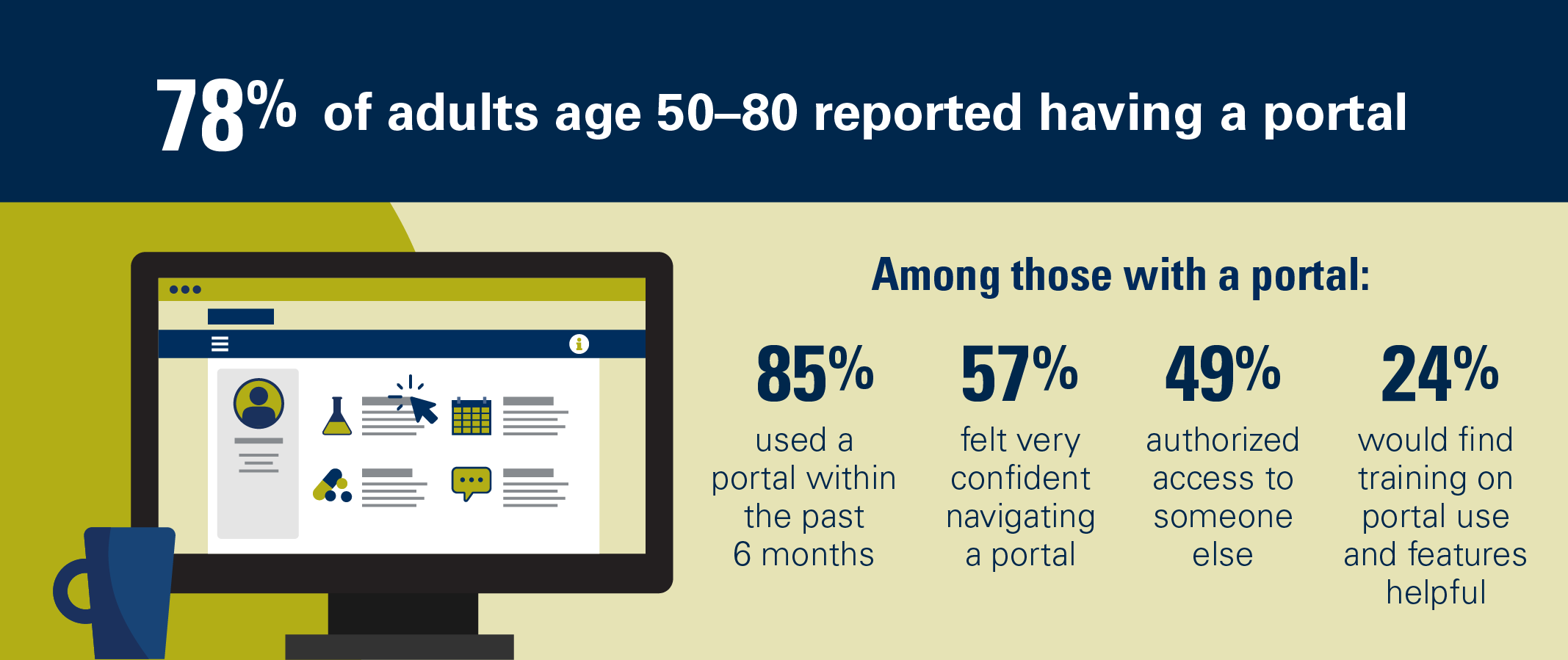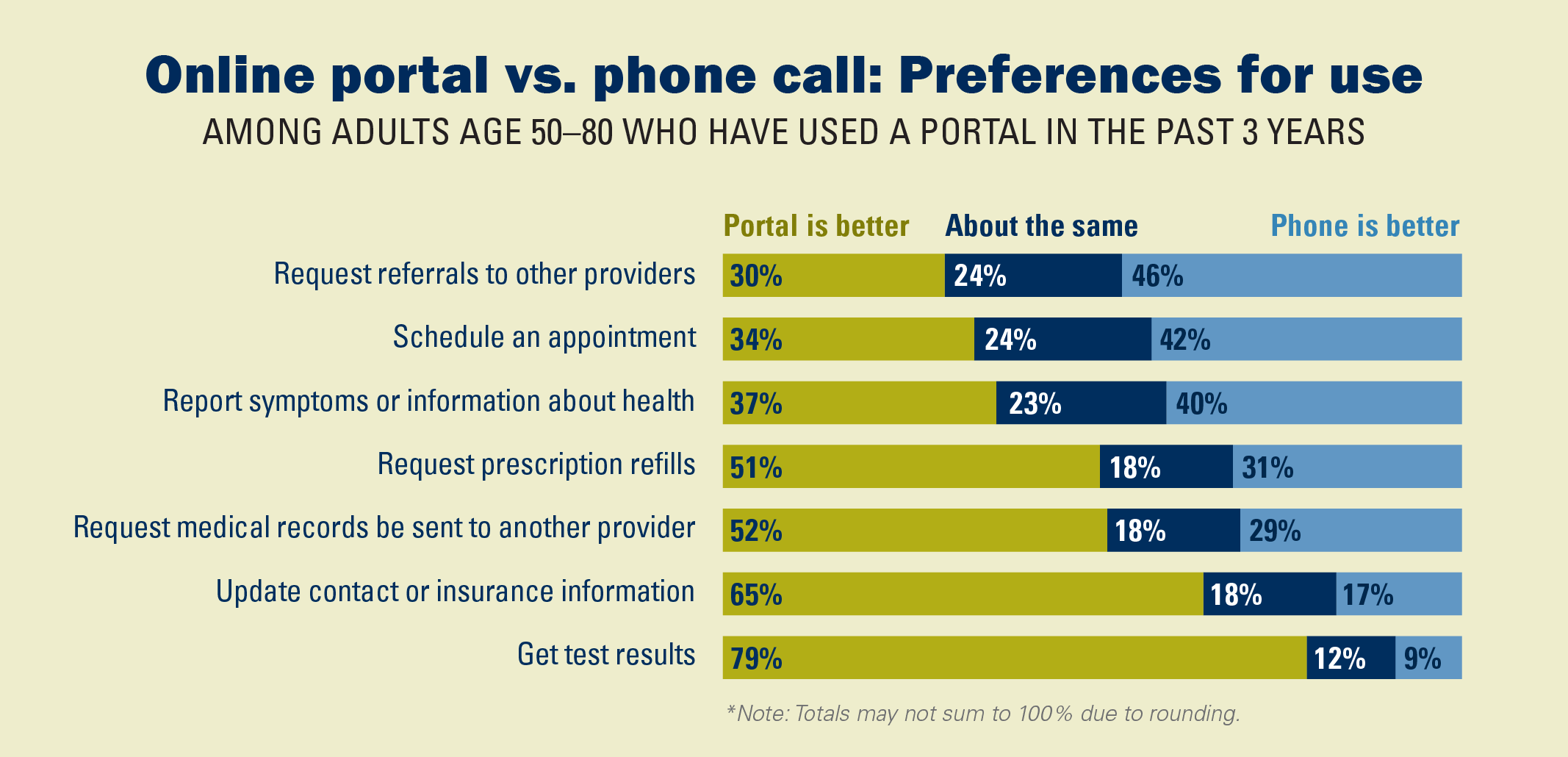
For many people, online patient portals have become an important tool to access their electronic health information, communicate with health care providers, and manage their health care. In January 2023, the University of Michigan National Poll on Healthy Aging asked a national sample of U.S. adults age 50–80 about their use of and experiences with patient portals.
Patient portal use
More than three in four adults age 50–80 (78%) reported having a patient portal, and 49% of those with a patient portal used more than one. Non-Hispanic White older adults were more likely to report having a patient portal than Hispanic or non-Hispanic Black older adults (80% vs. 73% vs. 69%). Having a patient portal was more common for those with an annual household income of $60,000 or more (88% vs. 67% of those with incomes below $60,000).
Over half of older adults with a patient portal (55%) reported using it within the past month, 30% one to six months ago, 8% seven to 12 months ago, 4% one to three years ago, and 3% indicated they had never used the portal or haven’t in over three years.
About half of patient portal users (49%) reported authorizing someone else to have access to their portal. Among portal users, 40% authorized access to a spouse or partner, 11% to an adult child, 4% to another family member, and fewer than 1% to a caregiver or friend.

Confidence in using portals
Over half of portal users (57%) said they were very confident logging in and navigating the portal, and 35% reported they were somewhat confident. More than three in five portal users (63%) were very confident that they knew how to contact their health care providers through the portal and another 30% were somewhat confident. Fewer than half of portal users expressed a high level of confidence in understanding portal information (48% very confident, 45% somewhat confident), knowing that portal information was secure (43% very confident, 46% somewhat confident), and getting a timely response from a health care provider if one was needed (35% very confident, 45% somewhat confident).
Portal users with fair or poor physical and/or mental health were about twice as likely as those in better health to say they were not confident logging in and navigating the portal, getting a timely response from a health care provider if one was needed, and understanding information in the portal.
Over one in three older adults who do not have a portal or have not used one in the past three years
(35%) were not confident that they could log in and navigate a portal if they were to use one. This percentage was higher among people with fair or poor physical health (62%), fair or poor mental health (58%), and those with health issues or disabilities that limit their daily activities (49%).
Nearly one in three older adults who do not use portals (31%) were not confident that their information would be secure, and 24% were not confident about getting a timely response from health care providers or understanding the information in the portal.
Among those who do not use a portal or have not used one recently, 26% said they do not do so because of concerns about privacy.
Comfort with using portals and what would be helpful
Among all adults age 50–80, 49% said they were comfortable using a patient portal. People less likely to be comfortable using a portal included non-Hispanic Black and Hispanic older adults, those with household incomes below $60,000, and those with fair or poor physical health (see data table on page 4).
Overall, more than one in four older adults (27%) reported that it would be helpful to receive training or a tutorial on portal use and features, including 36% without a portal and 24% with a portal. Non-Hispanic Black and Hispanic older adults and those with household incomes less than $60,000 were more likely to have said that training on portal use would be helpful (see table on page 4). One in four adults age 50–80 (25%) would like to learn how information on the portal is kept private and secure.

Online portal vs. phone call
When asked to compare using an online patient portal to making a phone call, the majority of those who have used a portal in the past three years said portals were better for getting test results (79% vs. 9% phone) and updating contact or insurance information (65% vs. 17% phone). Portals also ranked higher for authorizing others to access medical records (61% vs. 20% phone), requesting transfer of medical records to other providers (52% vs. 29% phone), and requesting prescription refills (51% vs. 31% phone).
In contrast, making a phone call was preferred for requesting a referral to other providers (46% vs. 30% portal), asking a question (45% vs. 36% portal), and scheduling appointments (42% vs. 34% portal). Older adults were split about their preference for using an online portal or making a phone call to report symptoms or other information about their health (40% phone, 37% portal).
Implications
In recent years, U.S. federal policies and investments by health care providers have increased the availability of digital health technologies. The COVID-19 pandemic led to greater adoption of digital health tools such as patient portals and virtual care. This poll shows that 78% of adults age 50–80 now have at least one patient portal, a significant increase from the 51% who said they had a portal as of March 2018. More than half of older adults with a portal said they had used it within the past month, and nearly half had authorized access to their portal to someone else.
Despite this increase in portal use overall, differences in use remain, with non-Hispanic White older adults and those with higher incomes more likely to have a portal. In addition, those with lower incomes, who identify as Hispanic or non-Hispanic Black, and those with worse self-reported health, expressed less comfort using portals than others in this age group.
Portals can help patients engage in their health care and increase adherence to treatment, which may lead to better health outcomes. To the extent that portals can facilitate access to needed care and support patient engagement, lower use of portals by some groups may exacerbate health disparities.
Although most portal users were very or somewhat confident in their ability to log in to a portal,
understand information there, and receive a timely response from their health care providers, those with poorer health reported less confidence. Those not using portals, particularly those with worse health, expressed less confidence in their ability to use a portal and get timely responses from their
health care providers if they were to use one. These findings are particularly concerning, suggesting
those with poorer health may be less likely to experience the benefits of patient portals. Portals have also proven very useful for connecting people to virtual care and important health information during public health emergencies (e.g., the COVID-19 pandemic).
Although portal users ranked the online portal as better than making a phone call for some tasks such as getting test results and requesting prescription refills, they preferred the phone for requesting referrals, making appointments, and asking medical questions. These results suggest that, for many older adults, portals function more as a repository for information than a preferred tool for communicating with providers.
Overall, about one in four older adults say they would like training on portal features and information about how their personal health data are kept private and secure. These findings suggest that health systems and providers could be doing more to educate older adults about portal use, including how they can benefit from them and how their information is protected. Improving outreach and opportunities to increase knowledge about portals may help to reduce some barriers for those who are not using them regularly or have less confidence using them.
Data Source and Methods
This National Poll on Healthy Aging report presents findings from a nationally representative household survey conducted exclusively by NORC at the University of Chicago for the University of Michigan’s Institute for Healthcare Policy and Innovation. National Poll on Healthy Aging surveys are conducted using NORC’s AmeriSpeak probability-based panel. This survey module was administered online and via phone in January 2023 to a randomly selected, stratified group of U.S. adults age 50–80 (n=2,563). The sample was subsequently weighted to reflect population figures from the U.S. Census Bureau. The completion rate was 61% among panel members contacted to participate. The margin of error is ±1 to 3 percentage points for questions asked of the full sample and higher among subgroups.
Findings from the National Poll on Healthy Aging do not represent the opinions of the University of Michigan. The University of Michigan reserves all rights over this material.
Read other National Poll on Healthy Aging reports and about the poll's Michigan findings, and learn about the poll methodology.
Citation
Anthony D, Singer D, Kirch M, Solway E, Roberts S, Smith E, Hutchens L, Malani P, Kullgren J. Use and Experiences with Patient Portals Among Older Adults. University of Michigan National Poll on Healthy Aging. May/June 2023. Available at: https://dx.doi.org/10.7302/7226